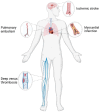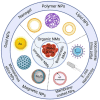Advances in Nano-Functional Materials in Targeted Thrombolytic Drug Delivery
- PMID: 38792186
- PMCID: PMC11123875
- DOI: 10.3390/molecules29102325
Advances in Nano-Functional Materials in Targeted Thrombolytic Drug Delivery
Abstract
Thrombotic disease has been listed as the third most fatal vascular disease in the world. After decades of development, clinical thrombolytic drugs still cannot avoid the occurrence of adverse reactions such as bleeding. A number of studies have shown that the application of various nano-functional materials in thrombus-targeted drug delivery, combined with external stimuli, such as magnetic, near-infrared light, ultrasound, etc., enrich the drugs in the thrombus site and use the properties of nano-functional materials for collaborative thrombolysis, which can effectively reduce adverse reactions such as bleeding and improve thrombolysis efficiency. In this paper, the research progress of organic nanomaterials, inorganic nanomaterials, and biomimetic nanomaterials for drug delivery is briefly reviewed.
Keywords: biomimetic nanomaterials; drug delivery system; inorganic nanomaterials; organic nanomaterials; thrombolytic drugs; thrombosis.
Conflict of interest statement
The authors declare no conflicts of interest.
Figures








Similar articles
-
Photothermal-Therapy-Based Targeting Thrombolytic Therapy.ACS Appl Bio Mater. 2025 Mar 17;8(3):1820-1834. doi: 10.1021/acsabm.4c01820. Epub 2025 Feb 24. ACS Appl Bio Mater. 2025. PMID: 39992813 Review.
-
Novel and emerging therapies: thrombus-targeted fibrinolysis.Semin Thromb Hemost. 2013 Feb;39(1):48-58. doi: 10.1055/s-0032-1328935. Epub 2012 Oct 3. Semin Thromb Hemost. 2013. PMID: 23034825 Review.
-
Cutting-edge advances in nano/biomedicine: A review on transforming thrombolytic therapy.Biochem Pharmacol. 2024 Nov;229:116523. doi: 10.1016/j.bcp.2024.116523. Epub 2024 Sep 7. Biochem Pharmacol. 2024. PMID: 39251141 Review.
-
Fibrinogen binding to activated platelets and its biomimetic thrombus-targeted thrombolytic strategies.Int J Biol Macromol. 2024 Aug;274(Pt 1):133286. doi: 10.1016/j.ijbiomac.2024.133286. Epub 2024 Jun 21. Int J Biol Macromol. 2024. PMID: 38908635 Review.
-
Progress of nanomaterials in the treatment of thrombus.Drug Deliv Transl Res. 2024 May;14(5):1154-1172. doi: 10.1007/s13346-023-01478-6. Epub 2023 Nov 25. Drug Deliv Transl Res. 2024. PMID: 38006448 Review.
Cited by
-
Optimization and characterization of collagenase KU665299 and its application in effective in-vitro clot digestion.Biotechnol Lett. 2025 Jul 22;47(4):79. doi: 10.1007/s10529-025-03615-2. Biotechnol Lett. 2025. PMID: 40694201
-
Targeting hemostatic enzymes: from mechanistic insights to therapeutic frontiers.Curr Opin Hematol. 2025 Sep 1;32(5):253-260. doi: 10.1097/MOH.0000000000000884. Epub 2025 Jul 14. Curr Opin Hematol. 2025. PMID: 40662421 Review.
-
From micro to macro, nanotechnology demystifies acute pancreatitis: a new generation of treatment options emerges.J Nanobiotechnology. 2025 Jan 29;23(1):57. doi: 10.1186/s12951-025-03106-6. J Nanobiotechnology. 2025. PMID: 39881355 Free PMC article. Review.
-
Nanomedicine in cardiovascular and cerebrovascular diseases: targeted nanozyme therapies and their clinical potential and current challenges.J Nanobiotechnology. 2025 Jul 28;23(1):543. doi: 10.1186/s12951-025-03590-w. J Nanobiotechnology. 2025. PMID: 40717066 Free PMC article. Review.
-
Systemic Impact of Platelet Activation in Abdominal Surgery: From Oxidative and Inflammatory Pathways to Postoperative Complications.Int J Mol Sci. 2025 Jul 24;26(15):7150. doi: 10.3390/ijms26157150. Int J Mol Sci. 2025. PMID: 40806279 Free PMC article. Review.
References
-
- Hu S., Wang Z. An Overview of the “China Cardiovascular Health and Disease Report 2022”. Chin. J. Cardiovasc. Rev. 2023;21:577–600.
-
- Tsao C.W., Aday A.W., Almarzooq Z.I., Anderson C.A.M., Arora P., Avery C.L., Baker-Smith C.M., Beaton A.Z., Boehme A.K., Buxton A.E., et al. Heart Disease and Stroke Statistics-2023 Update: A Report from the American Heart Association. Circulation. 2023;147:e93–e621. - PubMed
-
- Bikdeli B., Madhavan M.V., Jimenez D., Chuich T., Dreyfus I., Driggin E., Nigoghossian C., Ageno W., Madjid M., Guo Y., et al. COVID-19 and Thrombotic or Thromboembolic Disease: Implications for Prevention, Antithrombotic Therapy, and Follow-Up: JACC State-of-the-Art Review. J. Am. Coll. Cardiol. 2020;75:2950–2973. doi: 10.1016/j.jacc.2020.04.031. - DOI - PMC - PubMed
Publication types
MeSH terms
Substances
Grants and funding
LinkOut - more resources
Full Text Sources
Medical

